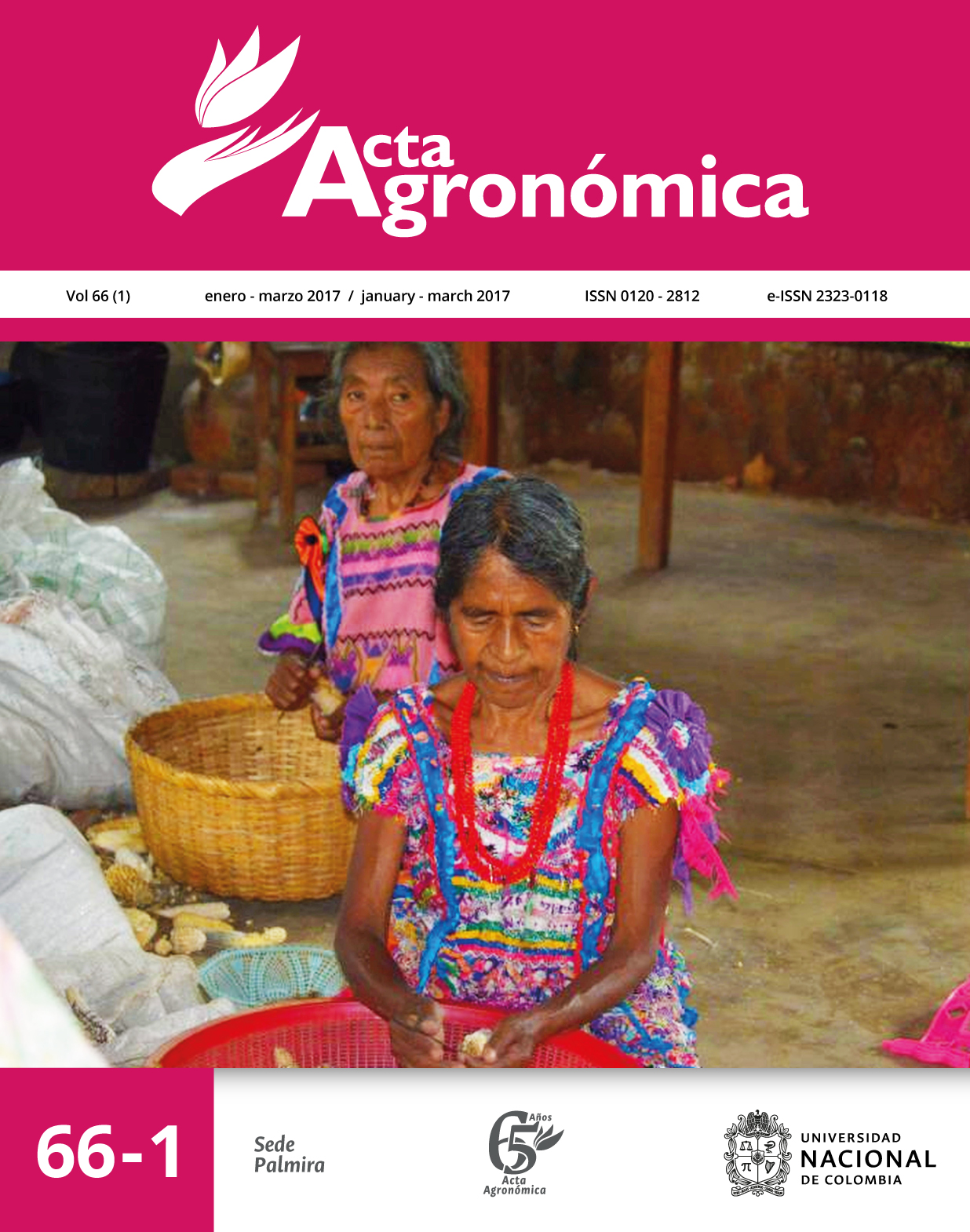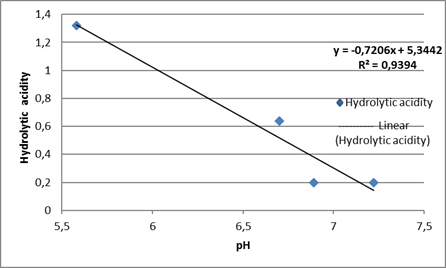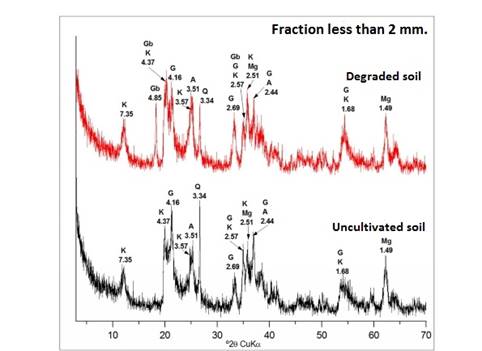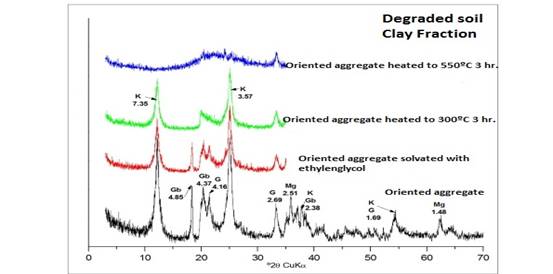Degradation of Red Ferralitic (Rhodic Ferralsol) soils grown with tobacco (Nicotiana tabacum L.) in the Artemisa province, Cuba
DOI:
https://doi.org/10.15446/acag.v66n1.52771Palabras clave:
Alkalinization, gibbsite, irrigation, profile, quality (es)
Descargas
“Partido” is a tobacco growing area which extends for some 3000 hectares among the municipalities of San Antonio de los Baños, Güira de Melena and Alquízar in the Cuban province of Artemisa. Predominant soils are Red Ferralitic (Rhodic Ferralsol according to the World Reference Base), with a strong tendency to alkalinization which has a negative impact on the quality of their agricultural use. The aim of this research was to quantify the geographical extension of the degradation process, to determine how deep it happens along the soil profile and to establish its possible relationship with the quality and quantity of water applied to tobacco fields. The chemical, physical and mineralogical analyses of two test pits carried out in the area were compared: one profile without agricultural use with one characteristic soil profile under continuous production. After being subjected to the same irrigation regime in laboratory conditions, it was concluded that degradation affects to 89.56% of the area of tobacco soils evaluated. This phenomenon occurs very deeply along the soil profile and happens downwards, causing the accumulation of calcium and the loss of sodium and potassium in the superficial horizon, what is shown in pH rises. Such processes, associated to irrigation water and to insufficient rainfall regime which are traditional in the territory, have led to changes in the mineralogical composition of these tobacco soils appearance of minerals such as gibbsite which was absent in uncultivated Red Ferralitic soils, which involve the modification of soil classification at gender level.
Recibido: 29 de agosto de 2015; Aceptado: 20 de noviembre de 2015
Abstract
"Partido" is a tobacco growing area which extends for some 3000 hectares among the municipalities of San Antonio de los Baños, Güira de Melena and Alquízar in the Cuban province of Artemisa. Predominant soils are Red Ferralitic (Rhodic Ferralsol according to the World Reference Base), with a strong tendency to alkalinization which has a negative impact on the quality of their agricultural use. The aim of this research was to quantify the geographical extension of the degradation process, to determine how deep it happens along the soil profile and to establish its possible relationship with the quality and quantity of water applied to tobacco fields. The chemical, physical and mineralogical analyses of two test pits carried out in the area were compared: one profile without agricultural use with one characteristic soil profile under continuous production. After being subjected to the same irrigation regime in laboratory conditions, it was concluded that degradation affects to 89.56% of the area of tobacco soils evaluated. This phenomenon occurs very deeply along the soil profile and happens downwards, causing the accumulation of calcium and the loss of sodium and potassium in the superficial horizon, what is shown in pH rises. Such processes, associated to irrigation water and to insufficient rainfall regime which are traditional in the territory, have led to changes in the mineralogical composition of these tobacco soils appearance of minerals such as gibbsite which was absent in uncultivated Red Ferralitic soils, which involve the modification of soil classification at gender level.
Keywords:
Alkalinization, gibbsite, irrigation, profile, quality.Resumen
La zona tabacalera de "Partido" abarca una superficie de 3000 hectáreas en los municipios de San Antonio de los Baños y Alquizar (provincia de Artemisa, Cuba). Los suelos predominantes son Ferralíticos Rojos, profundos, bien drenados y de reacción ligeramente ácida aunque, desde finales del siglo XX, se ha descrito una marcada tendencia a su alcalinización. El objetivo del presente trabajo es cuantificar la extensión geográfica de los procesos de degradación química de los suelos Ferralíticos Rojos en la zona de "Partido", evaluar la profundidad de estos procesos en el perfil del suelo y modelar la relación de los procesos de degradación con la calidad de las aguas y las normas de riego aplicadas al tabaco. Para ello, se compararon dos levantamientos de suelos realizados en la zona en 1994 (perfil típico) y 2012 (degradado), donde se concluye que la degradación química es un fenómeno que afecta a toda la profundidad del perfil. Estos fenómenos ocurren extensamente en la zona de estudio e intensamente en el tiempo, originando un cambio de clasificación del suelo a nivel de género. Por otro lado, se identificó un suelo Ferralítico Rojo compactado sin cultivar desde 1941. Una muestra del horizonte superficial fue sometida a un régimen alternado de riego y lluvia simulados. Se concluye que los procesos de degradación de los suelos Ferralíticos Rojos ocurren muy rápidamente y, al cabo de 20 - 35 períodos alternos de riego y lluvia (años), el suelo ya presenta las características típicas de los suelos degradados en la región.
Palabras clave:
Alcalinización, lluvia, perfil, riego, tabaco.Introduction
"Partido" area, extends for more than 3000 hectares located between the municipalities of San Antonio de los Baños, Güira de Melena and Alquízar in the Artemisa province, Cuba. It stands out for the high commercial value of its tobacco production, an intensive agricultural practice that has taken place since late XVIII century and currently, delivers more than half of the national wrapper production to make the export cigars, besides being included under the denomination of origin Habanos D.O.P. (Protected Denomination of Origin), as established by the Cuban Tobacco Research Institute (2012).
Predominant soils in the area are Red Ferralitic (Rhodic Ferralsol according to the World Reference Base), according to Hernández, Pérez, Bosch, & Rivero (1999), who describe them as deep, well-drained and light to moderate acid soils. However, results of further researchs (Cánepa, Trémols, Hernández, Monzón, & Valiente, 2012; Febles, Vega, Do Amaral, Tolón, & Lastra, 2014), even though they admit the importance of the soils within this genetic group for the Cuban agriculture, they have also warned over their marked evolution towards soil degradation, expressed in significant affectations in their major fertility indicators.
This situation is also present in the "Partido" tobacco growing area, for which reports are valid by Trémols, Cánepa, Monzón, Villalón, & Álvarez (2013), over the existence of a relationship between the scale of degradation and the continuous farming overexploitation; these authors also highlight that in Red Ferralitic soils subjected to intensive irrigation regime, the described characteristics can be recognized for such degradation process while soils of the same gender classification but cultivated under non irrigated conditions for the same time (more than 60 years) show no significant statistically variations in their fertility indicators.
Tobacco (Nicotiana tabacum L.) is an acidophilous plant whose yield and quality are affected by soil alkalinization (Tso, 1990).
This identifies as a demand of knowledge the assessment of the magnitude and effect of these alkalinization phenomena in this region for the Cuban tobacco production in order to have solid information for the draw-up of corresponding strategies for the recovery and management of the soils in the mentioned area.
The design and execution of the research performed were devoted to this objective.
Materials and methods
The relief of soils in the "Partido" tobacco area is flat, with slopes in general less than 2% according to the description by Hernández et al., (2014); according to Bernal (2009), the studied region belongs to an area where climate classifies as tropical sub-humid, with a wet season of an annual average rainfall of approximately 1500 mm and a dry season, suitable for tobacco cultivation, with figures between 300 and 350 mm. As for the temperature regime, he points out that annual average temperatures are of 24.7ºC, with a maximum average temperature of 29.8ºC and a minimum of 19.7ºC.
The origin material of the Red Ferralitic soils of the area is hard limestone from the Tertiary Period (Miocene-Neogene), that in most cases is found at depths between 2-3 meters or more (Hernández, Morales, Ascanio, Bojórquez, García, & García, 2006).
The soil of the studied area has been historically devoted to the tobacco and potato (Solanum tuberosum L.) productions since late XVIII century; natural vegetation is of semidecidious forests with some variations which, in the greater part of the territory, have been replaced by crops, pastures and scrubs (Hernández et al., 2014). Figure 1, shows the geographical location of the "Partido" area.
Figure 1: Location of the "Partido" tobacco growing area between the municipalities of San Antonio de los Baños, Güira de Melena and Alquízar (Artemisa province, Cuba).
In the municipality of San Antonio de los Baños areas of Red Ferralitic soils that were completely uncultivated since 1941 were identified; taking into consideration their representation and the absence of disturbances of man-made origin, a spot was selected where a test pit was dug, described and sampled according to the methodological guidelines by Hernández et al., (1995); once the profile was analyzed and checked its major parameters, match the genuineness criteria for uncultivated Red Ferralitic soils, according to Mesa, Colom, Trémols, Pena, & Suárez (1992), a sample of the superficial horizon was dried in the air, strained to 2 mm. and placed in plastic columns of 100 gr. capacity to be subjected to a simulated alternate irrigation regime and rainfall with the average values of the region and that the records of the Meteorology Institute set at 1500 mm. per year.
The water used for each irrigation cycle came from natural sources, allocated for tobacco irrigation in the studied area. Rain water used was previously collected at the beginning of the modeling stage.
Similarly, a test pit was dug in degraded soils areas (continuous increases in pH levels) and devoted uninterruptedly to tobacco production for decades; for the selection and location of the spot the genuineness as degraded soil was also taken into consideration.
Every irrigation and rain cycle was considered, by its effects on the soils, as equivalent to a calendar year. After every simulated irrigation and rain cycles, collected drainage waters were analyzed (pH, electric conductivity, total soluble salts and cations according to the National Bureau for Normalization, Metrology and Quality, 2006); at the time of setting up the experiment and at the end of the periods of 10, 20 and 35 cycles (years), samples were taken for similar analysis.
The test pits of Red Ferralitic soils were located at 22º52´10"N and 82º33´57" O for the uncultivated soil and at 22º51´10"N and 82º31´10"O for the degraded soil (Figure 2).
Figure 2: Georreferenced location of the test pits from uncultivated and degraded soils
Evaluation of soils properties was carried out according to the procedure established by Hernández et al. (1995), and taking into consideration the criteria developed for Red Ferralitic soils by Mesa et al.(1992), from samples that were dried in air conditions, grounded and strained to 0.5 and 2 mm for their analyses: hydrolytic acidity, pH in water and sodium chloride, interchangeable cations as well as the maximum hygroscopicity, capillary elevation and the upper plasticity limit were determined as physical indicators.
From both soil profiles (uncultivated and degraded), some characteristic samples were also taken from the horizon "A" up to 25 cm. deep (Hernández et al., 1995) that were dried in the air and strained to 2 mm. From every sample the clay fraction was extracted by sedimentation (≤ 2 μm; Klimes-Szmik, Suárez, Mesa, & Pena, 1980).
Mineralogical analyses were carried out to the fractions ≤ 2 mm and ≤ 2 μm of the samples for both soil conditions, X-Ray Diffraction (XRD) by using a diffractometer X´Pert with CuKαmonochroming radiation with graphite. In the case of the clay fraction, diffractograms from the disoriented powder preparations and from the following oriented additions were obtained: dry in the air, solvated in ethylene glycol, heated up to 300ºC and heated up to 500ºC for 3 hours. For the fraction ≤ 2 mm only disoriented powder preparations were performed.
For the qualitative analysis of the crystalline stages present in the samples the Power Difraction File was performed. The semiquantitative estimation of the content for these stages was carried out by using the standardized RIR method; the values of the Reference Intensity Reason (RIR) for every stage were obtained from the Powder Difraction Database of ICDD. General experiment conditions were established by the X-Ray Diffraction Services of the Agrarian Science Institute from the Scientific Research Upper Council based in Madrid (Spain).
Results and discussion
In Table 1, the results of the chemical, physical and physical-chemical analyses are shown for each soil condition.
Y1: Hydrolytic acidity, Hy: Maximum hygroscopicity, EC: Capilarry elevation in 5 hours; LSP: Plasticity upper levelTable 1: Chemical and physical properties of Red Ferralitic "uncultivated" and "degraded" soils

Although, the firsts reports over the degradation of Red Ferralitic soils (Cancio, 2002) only describe the rise in pH of soil superficial horizons or confirm the alkalinization of soils, together with a decline of the Ca/Mg relationship (González, Cánepa, Trémols, & Chávez, 2010; Cánepa et al., 2012), in Table 1, it is shown that the intensity of the described phenomenon reaches the whole soil profile, which allows to assume that it was not but the expression of a long-lasting and regular process of quality loss of this natural resource and that itself, far from being a logical consequence of the incidence of environmental factors for decades, is associated to the continuous farming in this region.
Soil alkalinization was present along the complete soil profile, together with a drastic decrease of the hydrolytic acidity and, correspondingly, by a drop of the soil potential acidity. At the same time, comparatively, an interchangeable calcium accumulation along the profile linked to a reduction of interchangeable magnesium occurred, while the levels of interchangeable potassium in the profile of the degraded soil are more related to the considerable quantity of potassic fertilizers that soils get under tobacco farming.
The change in the physical properties is consistent according to Mesa (1992), with the rise in clay contents along the whole profile, associated to the secondary formation of more active clay minerals, as a consequence of the degradation process.bTable 2, shows the results of the irrigation waters analyses.
*C.E: Electrical ConductivityTable 2: Irrigation water chemical analysis in the "Partido" area (average of 18 wells during the irrigation season).

It can be shown a significantly hardness based on the bicarbonate contents that characterize them; on the other hand, their slightly alkaline reaction represent as well a possible negative effect, derived from the possible salt precipitation to the inside of the irrigation systems and over the cultivated species (Ayers & Wescot, 1987).
That undesired second effect takes on great importance in the case of tobacco, because of the leaf being the yield aim. The significant accumulation of calcium in water irrigation constitutes a phenomenon associated to change in its quality, as an input for farming: its cause is rooted in depletion of sources and aquifers, in the occurrence of phenomena of sea intrusion, derived from a long-and-narrow-shaped island as Cuba and from long periods of drought that already affect the country, also as expression of the climate change effects that, according to what has been forecast by the INSMET, it will involve reductions up to 50% of typical rainfall during the wet season in the country.
The described situation with regards to the irrigation water quality and their effects over the farming quality in Cuba western Red Ferralitic soils. However, has also been approached from different perspectives by several authors: Valiente, Lobo & Palenzuela (2010), and Febles et al., (2014), among others.
Table 3, presents modeling results of the water quality effects in different category soils with respect to degradation.
*SST: Total Soluble SaltsTable 3: Composition of waters provided to soil by simulated irrigation and rainfall and corresponding drainages.

It is shown that, regardless of the period of intervention and the source of origin, irrigation facilitated the retention of calcium and the total soluble solids. Thus, the variations detected in the water analysis results keep a strong relationship with the results of soil analysis (Table 4).
Y1: Hydrolytic acidity; R: Irrigation; Ll: rainfallTable 4: Variation of properties of Red Ferralitic soils after different periods of simulated irrigation and rainfall.
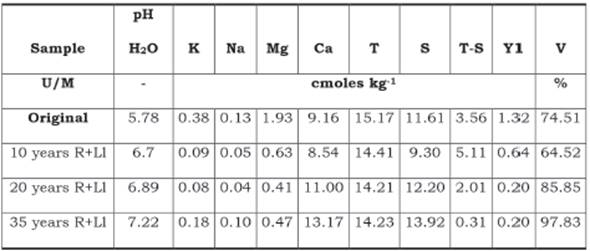
The explanation might be in the occurrence of typical transformation processes in soils of the Ferralitic genetic group (Ferralsol), which according to Gardi, Angelini, Barceló, Comerma, Cruz Gaistardo & Vargas, (2014), involve a strong weathering that leads to the loss of the majority of weathering minerals and to the washing of great quantities of siliceous and basic cations as it is shown in table 3. It is for this reason, many authors explain, that these soils are distinguished by the presence of stable compounds, such as kaolinite, aluminum and iron oxides, being the latter responsible for the red colour that identifies this genetic group.
This is the explanation for the pH increase ~ similar to the one that categorizes today the greater part of soils used in the tobacco productions and other farming in the Artemisa province ~the decrease of contents of potassium, sodium and magnesium as well as for the increase of calcium presence that is shown in table 4; such variations are due to transformations in soil structure (Mesa, 1992) and validate the design of the experiment and with it the hypothesis that degradation of soils in the "Partido" area are subjected to quality of irrigation water and the insufficient rainfall in this territory.
However, one should recognize as well that the absence of agroecological management practices and the intense and continuous regime of farming exploitation have also played a role in the decline of such an important natural resource (González et al., 2010; Cánepa et al., 2012).
It should be noted that the evolution of soil properties subjected to the regime of simulated irrigation and rainfall leads to changes in its classification at gender level; thus the original soil would classify as moderately desaturated Red Ferralitic (Hernández et al., 1995), only based on the effects of the simulation period equivalent to 10 years: it should be pointed out that with the treatment that models irrigation effects for 35 years, the degree of base saturation gets to 98%.
It should me mentioned that for the same soil subject to degradation factors in time, it is observed one inverse and statistically significant relationship between the pH (in water) and the hydrolytic acidity (Figure 3).
This can: be interpreted as evidence that with the rise of pH, the saturation by bases of the soil adsorbent complex has happened as well, what coincides with the statement by the Soil and Fertilizers General Management through the Agrochemical National Service, that in general, saturated soils show high values of pH in water.
A similar conclusion was offered by Mesa et al., (1992), for Red Ferralitic soils in general along the stretch of the Red Plain Havana-Matanzas.
Mineralogical composition
In the surface horizon of the Red Ferralitic soil in the "Partido" tobacco growing area occurred significant changes in the mineralogical composition of fraction ≤ 2 mm, under the effects of degradation processes (Figure 4).
Figure 4: Difractogram of the fraction ≤2 mm. Figures are values of d (x10-1 nm). Untagged peaks correspond to different diffraction orders than those consigned. K=kaolinite; Gb=gibbsite; G=goethite; A=anatase; Mg=maghemite and Q=quartz.
These changes are reflected in the decrease of peaks related to quartz and the appearance of gibbsite. Likewise in the semiquantitative characterization of this fraction (Table 5).
(-) UndetectedTable 5: Semiquantitative composition of the total fraction (≤2 mm) in uncultivated and degraded Red Ferralitic soil.

It is observed that quartz decreased by 2.25 times and goethite 1.7 times. On the other hand, the gibbsite was detected that was not present previously and the kaolinite rose by 1.44 times.
These differences seem to be related with the environment pedochemical conditions, where a significant increase in pH and calcium values have occurred. Yongue-Fouateu, Yemefack, Wouatong, Ndjigui, & Bilong (2009), described the effect of drainage in the formation of clay minerals, highlighting the necessity of a good drainage for the formation of kaolinite and gibbsite, as it happens under the conditions of the "Partido" tobacco growing area.
For the clay fraction (≤2 μm) similar changes are observed in the mineralogical composition of Red Ferralitic soils under the effects of degradation processes (Figures 5 and 6).
Figure 5: Difractogram of the fraction ≤2 mm. Figures are values of d (x10-1 nm). Untagged peaks correspond to different diffraction orders than those consigned. K=kaolinite; Gb=gibbsite; G=goethite; A=anatase; Mg=maghemite and Q=quartz.
Here, the: appearance of peaks in the refractograms of degraded soils is also observed, related to gibbsite, which was not present in uncultivated soils.
The semiquantitative composition of clay fraction (≤ 2 μm) shows that under the effect of degradation processes a decrease in the presence of goethite (3.2 times) and kaolinite (1.7 times) occurs while the maghemite increases almost to double (1.95 times) and the gibbsite appears (Table 6).
(-) UndetectedTable 6: Semiquantitative composition of the clay fraction (≤2 mm) in uncultivated and degraded Red Ferralitic soil.

This result coincides with Macías (1981), who describes the formation of gibbsite in periods of time relatively short and under different climate conditions. The conditions for the formation and stability of goethite and maghemite in soils are inverse and the rise of pH, as it occurs in the Red Ferralitic soils of the "Partido" tobacco region, favours the formation of the latter, while the first tends to decrease.
The presence of gibbsite involves changes in the soil classification at gender level and explains or provides elements over the fact that for soils classified as Red Ferralitic in the current Artemisa province, over the last 20 years the presence of saturated gender areas has increased by 93% for soils of the typical subtype and by 72% for the compacted subtype and in the entirety for the hydrated and leached subtypes, reported by Trémols et al., (2013).
Conclusions
Degradation of tobacco soils classified as Red Ferralitic in the "Partido" area (Artemisa province, Cuba) affects 89.56% of the total farming area. Soil affectation typifies by the increase of pH to moderately alkaline, the accumulation of calcium and the high saturation by bases, taking place along the whole soil profile. The modeling work carried out with irrigation allowed to identify as the degradation responsible agent of these tobacco soils the hardness of irrigation water and the insufficient rainfall in the territory.
Acknowledgments
To Noel J. Arozarena Daza (Alejandro de Humboldt Tropical Agriculture Research Institute) and Abdón Joaquín Trémols González (Rest in Peace).
References
Referencias
Ayers, R.S. & Westcot, D.W. (1987). Quality of water for agriculture. Roma: FAO. p 97.
Bernal, A. (2009). Anthropogenic and climate conditions influence on aggregates structural stability of leached Red Ferralitic soils in the Havana province. INCA. pp 63.
Cancio, R. (2002). Report on pH changes in soils of various farming enterprises of the Havana province. Instituto de Suelos. Ciudad de La Habana, Cuba.
Cánepa, Y., Trémols, J., Hernández, A., Monzón, L., & Valiente, M.C. (2012). Chemical degradation of Red Ferralitic soils of the tobacco Entreprise “Lázaro Peña”. Cubatabaco, 13(1), 69-72.
Febles, J.M., Vega, M.B., Do Amaral, N., Tolón, A., & Lastra, X. (2014). Good Soils in Extinction: Degradation of Red Ferralitic Soils in Western Cuba. Soil Sci, 179(6), 304-313. doi: 10.1097/SS.0000000000000070.
Gardi, C., Angelini, M., Barceló, S., Comerma, J., Cruz Gaistardo, C., & Vargas, R. (2014). Soil Atlas of Latin America and the Caribbean. Luxembourg: Oficina de Publicaciones de la Unión Europea (eds.). doi: 10.2788/37334.
González, A., Cánepa, Y., Trémols, J., & Chávez, L. (2010). Diagnosis of soil degradation by zones of the tobacco Entreprise “Lázaro Peña”. Cubatabaco, 11(2). 32-38.
Hernández, A., Pérez, J.M., Bosch, D., & Rivero, L. (1999). New version to the genetic classification of Cuban soils. Instituto de Suelos. La Habana, AGRINFOR. pp.64.
Hernández, A., Morales, M., Ascanio, M.O., Bojórquez, J.I., García, N.E., & García, J.D. (2006). The soil: fundamentals on its formation, global changes and its use. México: Universidad Autónoma de Nayarit (eds.). pp.255.
Hernández, A., Morales, M., Borges, Y., Vargas, D., Cabrera, A., Ascanio,M. O.,...González, P. J. (2014). Properties degradation of leached Red Ferralitic soils of the “Red Plain Havana”, because of farming and some results over their improvement. Mayabeque, Cuba (eds.). p.78.
Instituto de Investigaciones del Tabaco. (2012). The World of the Habano. AGRINFOR (Eds.). p67.
Klimes-Szmik, A., Suárez, O., Mesa, A., & Pena, J. (1980). Soils of Cuba. Tomo II. La Habana: Editorial Orbe. pp 78.
Macías, F. (1981). Formation of gibbsite in soils and saprolites of temperate-humid zones. Clay minerals 16(1), 43-52. doi: 10.1180/claymin.1981.016.1.03.
Mesa, A., Colom, C., Trémols, J., Pena, J., & Suárez, O. (1992). Edaphological characteristics of Cuba. Ciudad de La Habana: Editorial Científico Técnica.
Oficina Nacional de Normalización, Metrología y Control de la Calidad. (2006). NC ISO/IEC 17025. Analysis of Water Quality. La Habana: ONNMCC. p97.
Trémols, A.J., Cánepa, Y., Monzón, L., Villalón, A., & Álvarez, L. (2013). Prediction of fertility evolution of a Red Ferralitic soil for tobacco (Nicotiana tabacum L.) production. Cubatabaco, 14(1). 18-25.
Tso, T. C. (1990). Production, Physiology and Biochemistry of tobacco plant. Ideals Inc (Eds.). USA. pp. 685.
Valiente, Ma. C., Lobo, J., & Palenzuela, Y. (2010). Chemical characterization of a Havana province tobacco soil and its use as quality control for soil chemical analysis at the Tobacco Research Institute. Cubatabaco, 11(1), 78-82.
Yongue-Fouateu, R., Yemefack, M., Wouatong, A.S.L., Ndjigui, P.D., & Bilong, P. (2009). Contrasted mineralogical composition of the laterite cover on serpentinites of Nkamouna-Kongo, southeast Cameroon. The Mineralogical Society, 44(2), 221-237.
Cómo citar
APA
ACM
ACS
ABNT
Chicago
Harvard
IEEE
MLA
Turabian
Vancouver
Descargar cita
Licencia
Derechos de autor 2017 Acta Agronómica

Esta obra está bajo una licencia internacional Creative Commons Atribución-NoComercial-SinDerivadas 4.0.
Política sobre Derechos de autor:Los autores que publican en la revista se acogen al código de licencia creative commons 4.0 de atribución, no comercial, sin derivados.
Es decir, que aún siendo la Revista Acta Agronómica de acceso libre, los usuarios pueden descargar la información contenida en ella, pero deben darle atribución o reconocimiento de propiedad intelectual, deben usarlo tal como está, sin derivación alguna y no debe ser usado con fines comerciales.



